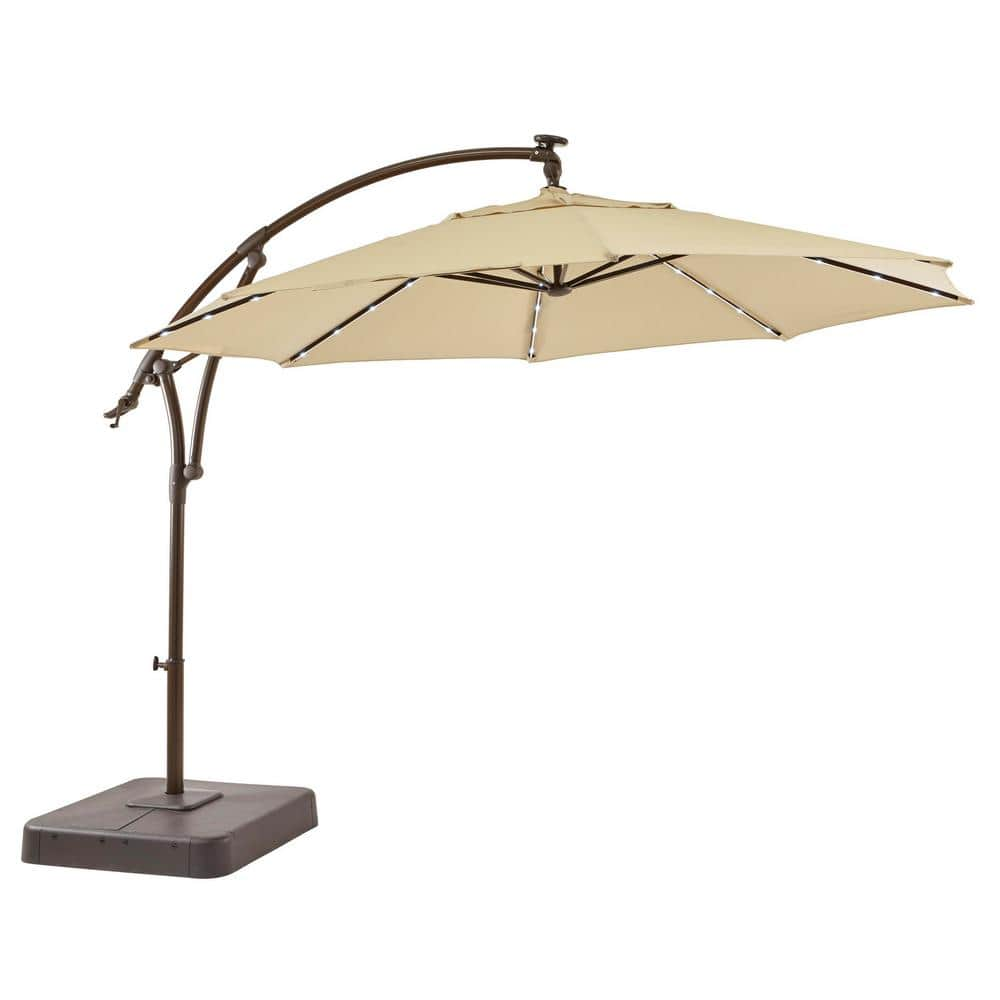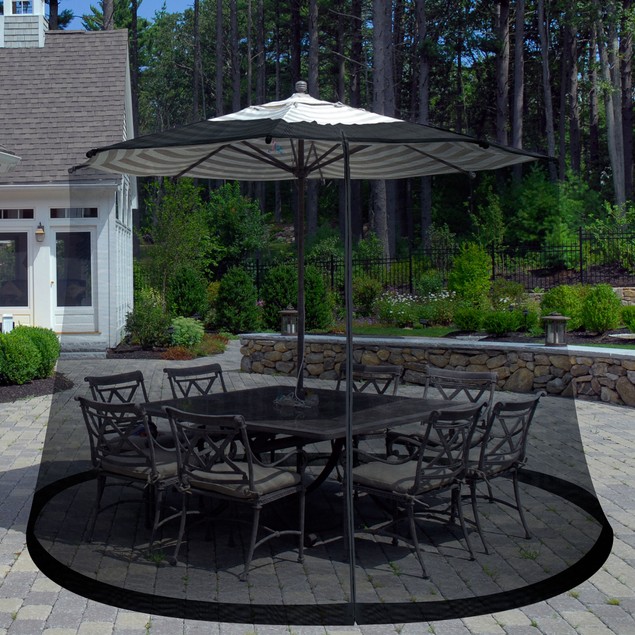Orbit Pro Series 4000 Sq. ft. Metal Gear-Drive Oscillating Lawn Sprinkler
-
( 3 Reviews )Rated 5.00 out of 5 based on 3 customer ratings03
The Orbit Pro Series oscillating sprinkler is ideal for watering large to extra-large rectangular areas. Easily slide the two tabs to adjust the spray distance from partial to full coverage, as needed, so the sprinkler can conform to the specific needs of your lawn. The wide metal base has been designed to make it easy to reposition your sprinkler and to keep your sprinkler from tipping during watering. Designed with precision nozzles, water is distributed evenly over the entire area. The plug at the end of the spray tube can easily unscrew to reveal a clean-out tool that will keep your nozzles from getting clogged by grit or debris.
-
Coleman SaluSpa 4 Person Portable Inflatable Outdoor Spa Hot Tub, Black
Rated 5.00 out of 505Coleman SaluSpa 4 Person Portable Inflatable Outdoor Spa Hot Tub, Black
Rated 5.00 out of 505 -
Pure Garden Outdoor Umbrella Screen – Black
Rated 5.00 out of 504Pure Garden Outdoor Umbrella Screen – Black
Rated 5.00 out of 504 -
Peony, Immaculee Seeds and Plants, Flowers
Rated 4.67 out of 503Peony, Immaculee Seeds and Plants, Flowers
Rated 4.67 out of 503
- The Orbit oscillator has a rectangular spray pattern up to 4, 000 square feet (depending on water pressure)
- Swivel connection and clean-out plug for easy installation and maintenance
- Adjustable tabs to change the spray distance and pattern as needed
- Precision nozzles provide consistent water coverage
- Heavy-duty metal base to keep your sprinkler from tipping over
Additional information
| Assembled Product Weight | 2.6 lb. |
|---|---|
| Assembled Product Dimensions (L x W x H) | 18.75 x 6.13 x 2.75 Inches |
4000 or variation, may refer to:
- 4000 (number)
- 4000 BCE, a year in the 4th millennium BC
- A.D. 4000, the last year of the 4th millennium CE, a century leap year starting on Saturday
- 4000s AD, a decade, century, millennium in the 5th millennium CE
- 4000s BCE, a decade, century, millennium in the 5th millennium BC
- 4000 Hipparchus, an asteroid in the Asteroid Belt, the 4000th asteroid registered
- Mobro 4000, a barge operated by MOBRO
- Weather Star 4000, a computer system used to display local forecasts on The Weather Channel
- Hawker 4000, a supermidsized businessjet
- Delta 4000, a rocket series
- Audi 4000, a compact executive sedan
- 4000 (District of Shkodër), one of the postal codes in Albania
- 4000-series integrated circuits
A gear is a rotating circular machine part having cut teeth or, in the case of a cogwheel or gearwheel, inserted teeth (called cogs), which mesh with another (compatible) toothed part to transmit rotational power. While doing so, they can change the torque and rotational speed being transmitted (in inverse proportion) and also change the rotational axis of the power being transmitted. The teeth on the two meshing gears all have the same shape.
The basic principle behind the operation of gears is analogous to the basic principle of levers. Meshing gears of different diameters produce three changes — (i) a change in torque, creating a mechanical advantage, (ii) an inverse change in rotational speed and (iii) a change in the sense of the rotation, a clockwise rotation becoming an anti-clockwise one and vice-versa. The ratio of the output torque to the input torque is equal to the ratio of the diameter of the output gear to that of the input gear τout⁄τin = diaout⁄diain. This is called the gear ratio. The ratio of the output rotational speed to the input rotational speed is equal to the inverse of the ratio of the diameter of the output gear to that of the input gear ωout⁄ωin = (diaout⁄diain)-1 = diain⁄diaout. The diameters of the gears are measured at a point between the root and tips of the gear teeth called the pitch circle.
A gear may also be known informally as a cog.
Two or more meshing gears, working in a sequence, are called a gear train or a transmission. The gears in a transmission are analogous to the wheels in a crossed, belt pulley system. An advantage of gears is that the teeth of a gear prevent slippage. In transmissions with multiple gear ratios—such as bicycles, motorcycles, and cars—the term "gear" (e.g.,e "first gear") refers to a gear ratio rather than an actual physical gear. The term describes similar devices, even when the gear ratio is continuous rather than discrete, or when the device does not actually contain gears, as in a continuously variable transmission (CVT). Sometimes a CVT is referred to as an "infinitely variable transmission".
Furthermore, a gear can mesh with a linear toothed part, called a rack, producing movement in a straight line instead of rotation (movement in a circle). See Rack and Pinion for an example.
A lawn () is an area of soil-covered land planted with grasses and other durable plants such as clover which are maintained at a short height with a lawn mower (or sometimes grazing animals) and used for aesthetic and recreational purposes—it is also commonly referred to as part of a garden. Lawns are usually composed only of grass species, subject to weed and pest control, maintained in a green color (e.g., by watering), and are regularly mowed to ensure an acceptable length. Lawns are used around houses, apartments, commercial buildings and offices. Many city parks also have large lawn areas. In recreational contexts, the specialised names turf, pitch, field or green may be used, depending on the sport and the continent.
The term "lawn", referring to a managed grass space, dates to at least the 16th century. With suburban expansion, the lawn has become culturally ingrained in some areas of the world as part of the desired household aesthetic. However, awareness of the negative environmental impact of this ideal is growing. In some jurisdictions where there are water shortages, local government authorities are encouraging alternatives to lawns to reduce water use. Researchers in the United States have noted that suburban lawns are "biological deserts" that are contributing to a "continental-scale ecological homogenization." Lawn maintenance practices also cause biodiversity loss in surrounding areas.
A metal (from Ancient Greek μέταλλον (métallon) 'mine, quarry, metal') is a material that, when freshly prepared, polished, or fractured, shows a lustrous appearance, and conducts electricity and heat relatively well. Metals are typically ductile (can be drawn into wires) and malleable (they can be hammered into thin sheets). These properties are the result of the metallic bond between the atoms or molecules of the metal.
A metal may be a chemical element such as iron; an alloy such as stainless steel; or a molecular compound such as polymeric sulfur nitride.
In physics, a metal is generally regarded as any substance capable of conducting electricity at a temperature of absolute zero. Many elements and compounds that are not normally classified as metals become metallic under high pressures. For example, the nonmetal iodine gradually becomes a metal at a pressure of between 40 and 170 thousand times atmospheric pressure. Equally, some materials regarded as metals can become nonmetals. Sodium, for example, becomes a nonmetal at pressure of just under two million times atmospheric pressure, though at even higher pressures it is expected to become a metal again.
In chemistry, two elements that would otherwise qualify (in physics) as brittle metals—arsenic and antimony—are commonly instead recognised as metalloids due to their chemistry (predominantly non-metallic for arsenic, and balanced between metallicity and nonmetallicity for antimony). Around 95 of the 118 elements in the periodic table are metals (or are likely to be such). The number is inexact as the boundaries between metals, nonmetals, and metalloids fluctuate slightly due to a lack of universally accepted definitions of the categories involved.
In astrophysics the term "metal" is cast more widely to refer to all chemical elements in a star that are heavier than helium, and not just traditional metals. In this sense the first four "metals" collecting in stellar cores through nucleosynthesis are carbon, nitrogen, oxygen, and neon, all of which are strictly non-metals in chemistry. A star fuses lighter atoms, mostly hydrogen and helium, into heavier atoms over its lifetime. Used in that sense, the metallicity of an astronomical object is the proportion of its matter made up of the heavier chemical elements.
Metals, as chemical elements, comprise 25% of the Earth's crust and are present in many aspects of modern life. The strength and resilience of some metals has led to their frequent use in, for example, high-rise building and bridge construction, as well as most vehicles, many home appliances, tools, pipes, and railroad tracks. Precious metals were historically used as coinage, but in the modern era, coinage metals have extended to at least 23 of the chemical elements.
The history of refined metals is thought to begin with the use of copper about 11,000 years ago. Gold, silver, iron (as meteoric iron), lead, and brass were likewise in use before the first known appearance of bronze in the fifth millennium BCE. Subsequent developments include the production of early forms of steel; the discovery of sodium—the first light metal—in 1809; the rise of modern alloy steels; and, since the end of World War II, the development of more sophisticated alloys.
In celestial mechanics, an orbit (also known as orbital revolution) is the curved trajectory of an object such as the trajectory of a planet around a star, or of a natural satellite around a planet, or of an artificial satellite around an object or position in space such as a planet, moon, asteroid, or Lagrange point. Normally, orbit refers to a regularly repeating trajectory, although it may also refer to a non-repeating trajectory. To a close approximation, planets and satellites follow elliptic orbits, with the center of mass being orbited at a focal point of the ellipse, as described by Kepler's laws of planetary motion.
For most situations, orbital motion is adequately approximated by Newtonian mechanics, which explains gravity as a force obeying an inverse-square law. However, Albert Einstein's general theory of relativity, which accounts for gravity as due to curvature of spacetime, with orbits following geodesics, provides a more accurate calculation and understanding of the exact mechanics of orbital motion.
Pro is an abbreviation meaning "professional".
Pro, PRO or variants thereof might also refer to:
Sprinkler may refer to:
- Irrigation sprinkler, a device for watering lawns or crops
- Fire sprinkler, a device for fire suppression
- Sprinkler (dance), a dance move






by David
This sprinkler is heavy duty. It sprays a lot of water and covers a bigger area than most. I brought one for my back yard and it worked so well, I brought one for the front yard. It’s a little pricey, but worth the money.
by Michael
works great, smooth oscillation.
by Steve
I don’t know how they came up with that it covers 4,000 Sq ft, but it is very strong %26 I got it to actually cover 500 Sq ft 22.5′ x 22.5′. So of the 4 I bought I used only 2, to cover @ a 1,000 sq ft area. . My neighbor uses his sprinkler in 4 sections to cover 800 square ft. He has to move his 4 times. 2 of these n he’d be done.